Articles | Technical
How New Mass Timber GIB® Encapsulation Systems Supports Fire Safety in Built Environments
Monday, 21 August 2023
By Frank Kang
One of fastest growing environmentally friendly building materials is one that is centuries old, with mass timber becoming hugely popular in New Zealand over recent years. According to the World Economic Forum, cross-laminated timber, as it’s also known, is as big an innovation for the building sector as the invention of reinforced concrete more than 150 years ago.
Designers and engineers can now create practically any type of building using timber, from high rise commercial office spaces to multi-purpose residential projects. Examples like the Tauranga City Council premises, which is now under construction, is utilising mass timber to achieve a net zero emissions build. The building is set to become New Zealand’s largest mass timber building when completed in 2024.

An artist’s impression of Tauranga City Council’s new office building, which is set to be the largest mass timber office building in New Zealand. This building targets a net zero carbon footprint for the building’s construction process.
Cross-laminated timber and other engineered wood products benefit the climate in a multitude of ways. Trees capture and store carbon as they grow and long-lived wood products then lock the carbon in. They are also a lower carbon emission substitution for materials like concrete and steel, with some reports suggesting they could reduce building emissions by as much as 15-20%.
Building with mass timber also contributes to lighter builds, offering highly precise production with offsite prefabrication, and faster overall construction times which can further reduce costs, so it’s easy to see why it’s become so popular.
Challenges to fire safety
Mass timber construction poses some significant fire safety challenges however, given the mass timber is combustible, which can contribute significantly to the overall fuel load inside the building compartment.
Current New Zealand Building Code C/VM Verification Method and C/AS Acceptable Solution documents do not adequately address the additional fuel load contributed by the exposed mass timber.
Encapsulating mass timber with GIB® plasterboard
One way to mitigate the fuel load and avoid the need for separate fire severity calculations is to encapsulate mass timber with plasterboard.
Winstone Wallboards recommends ‘universal’ lining systems such as GBUW and GBUC specifications for mass timber wall and floor applications respectively. ‘Universal’ lining systems are designed to limit back-of-lining temperature and protect mass timber from char so are suitable for mass timber encapsulation. Recent fire resistance testing has also shown that additional encapsulation systems are possible with an open or insulated cavity. Table 1 summarises mass timber GIB® encapsulation systems for mass timber walls and floors.
Some systems allow limited unsealed service penetrations through battened wall linings or suspended ceiling linings. It may have up to 4 evenly distributed unsealed service penetrations per m2, each not exceeding 100mm in diameter of equivalent area. All outer layer fastener heads stopped and sheet joints tape reinforced in accordance with the publication entitled “GIB® Site Guide”. Inner layer can be left unstopped.
Want to know more?
If you’re keen to know more about mass timber encapsulation system we’ve recently updated our GIB® Fire Rated Systems Supplement, which is available on our website or call the GIB® Helpline on 0800 100 442.
Table 1: Mass timber GIB® encapsulation systems summary table
Read next
Articles | People
Earthquake Engineer ‘Shakes Things Up’ with a New Life in New Zealand
Wednesday, 12 July 2023 By Siobhan Page